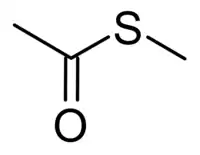 | |
| Identifiers | |
|---|---|
3D model (JSmol) |
|
| ChEBI | |
| ChemSpider | |
| ECHA InfoCard | 100.014.775 |
PubChem CID |
|
| UNII | |
CompTox Dashboard (EPA) |
|
| |
| |
| Properties | |
| C3H6OS | |
| Molar mass | 90.14 g·mol−1 |
Except where otherwise noted, data are given for materials in their standard state (at 25 °C [77 °F], 100 kPa).
Infobox references | |
S-Methyl thioacetate is a natural product found in many plant species. In its pure form it has an unpleasant sulfurous smell, but when highly diluted and along with other simple alkyl thioacetates and related compounds, it is an important component of the smell and flavour profile of some foods, especially Camembert cheese.[1][2]
Alternate isomer

O-methyl ethanethioate, CAS# 21119-13-1[3]
The constitutional isomer in which the oxygen and sulfur atoms are interchanged, O-methyl thioacetate, is also commonly known as methyl thioacetate and found as a natural product and flavor component in some foods, such as fish sauce and some kinds of melon.[4][5]
See also
References
- ↑ Sablé S, Cottenceau G (December 1999). "Current knowledge of soft cheeses flavor and related compounds". Journal of Agricultural and Food Chemistry. 47 (12): 4825–36. doi:10.1021/jf990414f. PMID 10606538.
- ↑ Martínez-Cuesta Mdel C, Peláez C, Requena T (2013). "Methionine metabolism: major pathways and enzymes involved and strategies for control and diversification of volatile sulfur compounds in cheese". Critical Reviews in Food Science and Nutrition. 53 (4): 366–85. doi:10.1080/10408398.2010.536918. PMID 23320908. S2CID 27793531.
- ↑ "Methyl thioacetate". PubChem. U.S. National Library of Medicine.
- ↑ Shimoda, M.; Yamamoto, Y.; Cocunubo-Castellanos, J.; Yoshimura, T.; Miyake, M.; Ishikawa, H.; Osajima, Y. (2000). "Deodorization of Fish Sauce by Continuous-Flow Extraction with Microbubbles of Supercritical Carbon Dioxide". Journal of Food Science. 65 (8): 1349–1351. doi:10.1111/j.1365-2621.2000.tb10610.x.
- ↑ Dos-Santos N, Bueso MC, Fernández-Trujillo JP (December 2013). "Aroma volatiles as biomarkers of textural differences at harvest in non-climacteric near-isogenic lines of melon". Food Research International. 54 (2): 1801–1812. doi:10.1016/j.foodres.2013.09.031.
This article is issued from Wikipedia. The text is licensed under Creative Commons - Attribution - Sharealike. Additional terms may apply for the media files.